Hiking in the heart of the Cevennes |

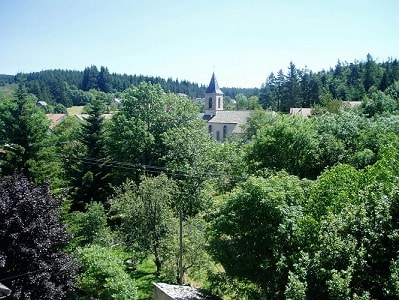 Morning departure under the bright sun. The beautiful weather settles in. Upon leaving La Bastide-Puylaurent, the Stevenson Trail quickly returns to the vast open spaces of the Gardille forest, which I traversed just the day before. The wind sweeps across the plateau, and its mournful music permeates this vast solitude; what causes it to exult one day and then bring anxiety the next? The Stevenson path reconnects with the valley for a final meeting with the young Allier River. The Chassezac also digs its first meanders here. A few hamlets are scattered along the valley. I especially remember a lovely hollow carpeted with daffodils and the robust, harmonious Romanesque church of Chasseradès... Inaccessible, alas, like many others! The effects of our era of vandalism and insecurity; these urban scourges reach even the depths of remote lands that one would think were preserved. Ah! The blessed priest of Chanteuges who, against all odds, maintains the hospitality of his admirable abbey and even enhances it with sacred music!
Morning departure under the bright sun. The beautiful weather settles in. Upon leaving La Bastide-Puylaurent, the Stevenson Trail quickly returns to the vast open spaces of the Gardille forest, which I traversed just the day before. The wind sweeps across the plateau, and its mournful music permeates this vast solitude; what causes it to exult one day and then bring anxiety the next? The Stevenson path reconnects with the valley for a final meeting with the young Allier River. The Chassezac also digs its first meanders here. A few hamlets are scattered along the valley. I especially remember a lovely hollow carpeted with daffodils and the robust, harmonious Romanesque church of Chasseradès... Inaccessible, alas, like many others! The effects of our era of vandalism and insecurity; these urban scourges reach even the depths of remote lands that one would think were preserved. Ah! The blessed priest of Chanteuges who, against all odds, maintains the hospitality of his admirable abbey and even enhances it with sacred music!
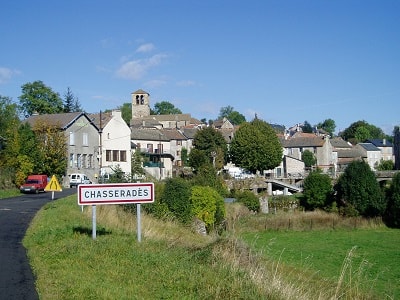 In the afternoon, there will be yet another great wandering through the rolling hills of Mount Goulet and its immense conifer forest. On the southern slope, I witness a new birth, as the Lot emerges in the heart of the forest massif and takes its first steps in a lovely valley, welcomed by birches, gorse, and daffodils. Three very different fates for three rivers born in the same massif; the Allier joins its fate with the Loire and ends its long course at the borders of Brittany; the Chassezac with the Ardèche winds through the depths of wild gorges on its way to the Mediterranean shores; and the Lot flows into the Garonne to mingle with the rich Bordeaux vineyards near the Atlantic. By chance of a valley, a hill, and the fates diverge. So it goes for the children of the same household. Stage of 25 km.
In the afternoon, there will be yet another great wandering through the rolling hills of Mount Goulet and its immense conifer forest. On the southern slope, I witness a new birth, as the Lot emerges in the heart of the forest massif and takes its first steps in a lovely valley, welcomed by birches, gorse, and daffodils. Three very different fates for three rivers born in the same massif; the Allier joins its fate with the Loire and ends its long course at the borders of Brittany; the Chassezac with the Ardèche winds through the depths of wild gorges on its way to the Mediterranean shores; and the Lot flows into the Garonne to mingle with the rich Bordeaux vineyards near the Atlantic. By chance of a valley, a hill, and the fates diverge. So it goes for the children of the same household. Stage of 25 km.
Today, I enter the "land of the Camisards." Finally, I would say; my attachment to the Cévennes is not foreign to my sympathy for these irreducible defenders of their faith. Leaving Le Bleymard and the Lot valley, the trail climbs the northern slope of Mount Lozère. A rather ordinary ascent to the Mont Lozère station (1421 m). One then reaches the summit desert, and climbs along the draille (the drailles are probably the oldest communication routes through the Cévennes). While they now bring joy to hikers, for many centuries, they served as transhumance routes for flocks of sheep, especially those moving from the southern plains to the Méjean plateau, the Larzac, the Tanargue, Lozère... Pierre A. Clement has dedicated an exciting book to them, "In Cévennes with the Shepherds."
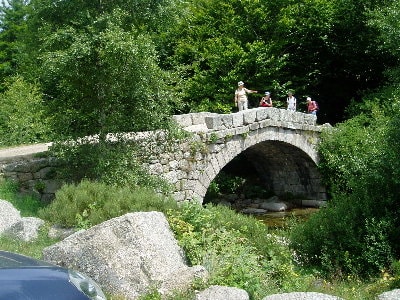 This historian from Languedoc traveled five of these mythical routes in the company of shepherds. And he describes this experience in savory tales, where hikers who have crisscrossed the Cévennes will certainly recognize many notable places.) marked by "montjoies" (The "montjoies" are tall granite markers, like those lining the draille on Mont Lozère, or stone assemblages. Their most obvious function is to mark the routes of transhumance and others, like the "cairns" that hikers are well acquainted with, particularly in the Pyrenees. However, the topo-guide notes that some "montjoies" date back to the Middle Ages and may have defined territories. Thus, the Maltese crosses carved on some of the upright stones in Lozère may have marked the properties of the Knights of Malta... I especially noticed the iconoclastic "tags"!).It is the kingdom of the wind, which sweeps across the moor of stones and low grass. The hiker braces himself until he reaches the summit of Pic Finiels (1699 m). It is the highest point of the massif and of my hike. All around, the infinite undulation of the ridges and valleys fades into a bluish mist; to the north, memory revisits the recent stages; to the south, imagination envisions the upcoming paths. And the mind wanders in this high solitude (shared for a moment, as the hiker from across the Rhine has joined me).
This historian from Languedoc traveled five of these mythical routes in the company of shepherds. And he describes this experience in savory tales, where hikers who have crisscrossed the Cévennes will certainly recognize many notable places.) marked by "montjoies" (The "montjoies" are tall granite markers, like those lining the draille on Mont Lozère, or stone assemblages. Their most obvious function is to mark the routes of transhumance and others, like the "cairns" that hikers are well acquainted with, particularly in the Pyrenees. However, the topo-guide notes that some "montjoies" date back to the Middle Ages and may have defined territories. Thus, the Maltese crosses carved on some of the upright stones in Lozère may have marked the properties of the Knights of Malta... I especially noticed the iconoclastic "tags"!).It is the kingdom of the wind, which sweeps across the moor of stones and low grass. The hiker braces himself until he reaches the summit of Pic Finiels (1699 m). It is the highest point of the massif and of my hike. All around, the infinite undulation of the ridges and valleys fades into a bluish mist; to the north, memory revisits the recent stages; to the south, imagination envisions the upcoming paths. And the mind wanders in this high solitude (shared for a moment, as the hiker from across the Rhine has joined me).
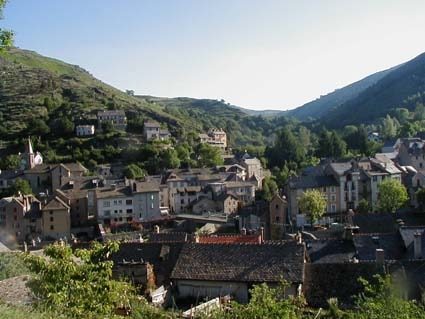 But our paths part quickly. The GR®70 is nothing but an almost uninterrupted descent towards Finiels and the Pont-de-Montvert. It is a somewhat rapid... and frustrating end to the stage: the weather is beautiful; and a few years ago, during an Easter hike, I promised myself to return to admire the blooming gorse of Lozère. The opportunity is too good. I can't resist taking a long loop via "GR®7." After the Finiels pass, the Languedoc draille is a bit lengthy on the old Roman road; but what enchantment when the narrow path tilts on the southern slope of the massif, it rushes down along a stream, winding between granite blocks and weaving through the gold of the gorse...
But our paths part quickly. The GR®70 is nothing but an almost uninterrupted descent towards Finiels and the Pont-de-Montvert. It is a somewhat rapid... and frustrating end to the stage: the weather is beautiful; and a few years ago, during an Easter hike, I promised myself to return to admire the blooming gorse of Lozère. The opportunity is too good. I can't resist taking a long loop via "GR®7." After the Finiels pass, the Languedoc draille is a bit lengthy on the old Roman road; but what enchantment when the narrow path tilts on the southern slope of the massif, it rushes down along a stream, winding between granite blocks and weaving through the gold of the gorse...
The draille continues its peaceful descent through the old deserted hamlets (Salarial, l'Hôpital) and reaches Pont-du-Tarn. The site lives up to my memory and even better in the spring, the clear water sparkles and sings on the rocks. My snack break is an idyllic moment of my hike.Now, I turn onto the GR72, which has nothing to envy of the GR7; for a few kilometers, it runs alongside the river that rushes in torrents across rocky debris. And the path also starts to tumble down through thickets of gorse spiked with granite chaos. Felgerolles, Merlet... and then the enchantment fades on the departmental road leading to Pont-de-Montvert. A little half-hour of asphalt is not too high a price to pay for a long jubilant run. Stage of 30 km.
 Pont-de-Montvert is a significant site of the "Camisard land." The temple, where a wooden pulpit of majestic simplicity stands, still attests to the liveliness of the Reformed faith. But how can one imagine that this beautiful and peaceful village was, in 1702, the birthplace of these dramatic events (the assassination of Abbot du Chayla and then the execution of the main leader, Pierre Séguier) that triggered such a terrible war? (It was on July 24, 1702, that Abbot du Chayla was assassinated at Pont-de-Montvert by a group of Protestants who came to demand the release of their co-religionists.
Pont-de-Montvert is a significant site of the "Camisard land." The temple, where a wooden pulpit of majestic simplicity stands, still attests to the liveliness of the Reformed faith. But how can one imagine that this beautiful and peaceful village was, in 1702, the birthplace of these dramatic events (the assassination of Abbot du Chayla and then the execution of the main leader, Pierre Séguier) that triggered such a terrible war? (It was on July 24, 1702, that Abbot du Chayla was assassinated at Pont-de-Montvert by a group of Protestants who came to demand the release of their co-religionists.
Abbot du Chayla, former priest of St-Germain-de-Calberte, condemned by the Church for embezzlement, had nevertheless been promoted thanks to his family and political connections. He was thus responsible for, among other tasks, the "muscular" evangelization of the Cévennes. His brutal zeal sparked the hatred of the Protestants... which reached its peak on that fateful evening in July 1702. Quickly arrested and judged as the leader of the murderers, Pierre Séguier, nicknamed Esprit Séguier for his inspired sermons, was condemned to have his hand cut off and to be burned alive at the very spot where his victim had perished, that is, in front of the clock tower of Pont-de-Montvert. Thus began a terrible war that would set the Cévennes ablaze for two years. Jean-Pierre Chabrol has evoked these terrible years in a very beautiful novel titled "The Madmen of God." One phrase only: "I drank, lips in the foam of the stream, while my soul quenched its thirst for the purity of kneeling like this, in the watercress of a spring rather than on the prayer desk of a chalk Saint Joseph, and kissing the water of the snows rather than the ring of a bishop."
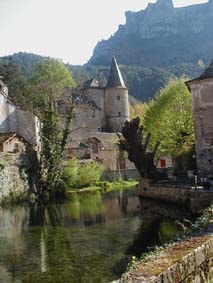 Today's stage of the GR70 does not follow the historical route to Florac. "A new road," writes the novelist, "leads from Pont-de-Montvert to Florac, through the Tarn valley. Its soft sandy bed develops approximately halfway between the peaks of the mountains and the river at the bottom of the valley." (R.L. Stevenson, "Travels with a Donkey in the Cévennes." Today it is D. 998 that winds along the Tarn. There is no question for a hiker to endure twenty kilometers of asphalt and road traffic! The GR70 offers Stevenson's followers solitude and high-altitude landscapes. Barely leaving Pont-de-Montvert via a beautiful cobbled path, the Cham de L'Hermet overlooks the stretched village in its hollow of hills at the confluence of the Lot, Rieumalet, and Martinet. And then on the slope of Bougès, it’s the ascent into a cathedral of conifers, to the sound of Eole's great organs. At the col de la Planette begins the long path on the bumpy spine of the Bougès mountain. It peaks at Signal du Bougès (1421 m.), whose dome is crowned by a monumental cairn. It’s a magnificent viewpoint. I take my revenge on that dreadful day in April 95, which was nothing but an uninterrupted race; rain and fog erased all these landscapes offered today under a azure sky from Mont Lozère to the valley of Mimente through the cliffs of Méjean. In the past two days, I have reached the summits (geographical, aesthetic, and mental) of my trip. Ah! To be able to prolong this state of freedom, serenity, peace... At the end of this beautiful journey, the terraces of Florac, shaded by plane trees, have a very southern charm, just a few steps from the source of the Peach... Stage of 25 km.
Today's stage of the GR70 does not follow the historical route to Florac. "A new road," writes the novelist, "leads from Pont-de-Montvert to Florac, through the Tarn valley. Its soft sandy bed develops approximately halfway between the peaks of the mountains and the river at the bottom of the valley." (R.L. Stevenson, "Travels with a Donkey in the Cévennes." Today it is D. 998 that winds along the Tarn. There is no question for a hiker to endure twenty kilometers of asphalt and road traffic! The GR70 offers Stevenson's followers solitude and high-altitude landscapes. Barely leaving Pont-de-Montvert via a beautiful cobbled path, the Cham de L'Hermet overlooks the stretched village in its hollow of hills at the confluence of the Lot, Rieumalet, and Martinet. And then on the slope of Bougès, it’s the ascent into a cathedral of conifers, to the sound of Eole's great organs. At the col de la Planette begins the long path on the bumpy spine of the Bougès mountain. It peaks at Signal du Bougès (1421 m.), whose dome is crowned by a monumental cairn. It’s a magnificent viewpoint. I take my revenge on that dreadful day in April 95, which was nothing but an uninterrupted race; rain and fog erased all these landscapes offered today under a azure sky from Mont Lozère to the valley of Mimente through the cliffs of Méjean. In the past two days, I have reached the summits (geographical, aesthetic, and mental) of my trip. Ah! To be able to prolong this state of freedom, serenity, peace... At the end of this beautiful journey, the terraces of Florac, shaded by plane trees, have a very southern charm, just a few steps from the source of the Peach... Stage of 25 km.
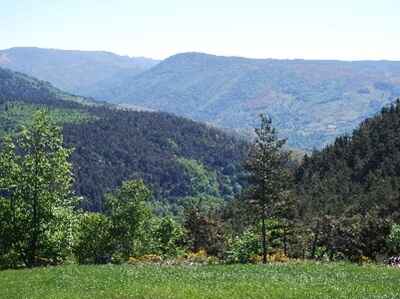 This Sunday morning, Florac is still asleep as I wander through its deserted streets. It is because, towards St-Germain-de-Calberte, I once again have a solid stage ahead. Quickly, with the GR70, I turn my back on the cliffs of the Méjean plateau and engage in the valley of the Mimente. The gradual altitude and the forest erase the rumblings of motor traffic. Here I am back in the great nature, in the heart of the Cévennes of chestnut trees. The robust and gnarled trunks, with their sculptural forms, colonize the slopes of the hills. Surprised as much as I am, a doe darts away in a crash of branches. At St-Julien-d'Arpaon, I descend to cross the river and then embark on a long, peaceful, and charming journey along the old railway; today, it is a pleasant grassy and flowery path that follows the meanders of the valley overlooking the emerald ribbon of the Mimente. At Cassagnas, the weather is bright and invites laziness... Why rush when there are barely a good ten kilometers left? But I must still "get going" and regain the heights of the hills. The path climbs back up into the forest; the slope is comfortable and does not detract from the pleasure of walking. The stele raised in memory of the Camisards at the Plan de Fontmort deserves a small detour on the "GR®7 - GR®67" coming from Barre-des-Cévennes. "Not far from this place, on my right, stood the famous Plan de Font Morte where Poul, with his Armenian scimitar, massacred Séguier's Camisards."
This Sunday morning, Florac is still asleep as I wander through its deserted streets. It is because, towards St-Germain-de-Calberte, I once again have a solid stage ahead. Quickly, with the GR70, I turn my back on the cliffs of the Méjean plateau and engage in the valley of the Mimente. The gradual altitude and the forest erase the rumblings of motor traffic. Here I am back in the great nature, in the heart of the Cévennes of chestnut trees. The robust and gnarled trunks, with their sculptural forms, colonize the slopes of the hills. Surprised as much as I am, a doe darts away in a crash of branches. At St-Julien-d'Arpaon, I descend to cross the river and then embark on a long, peaceful, and charming journey along the old railway; today, it is a pleasant grassy and flowery path that follows the meanders of the valley overlooking the emerald ribbon of the Mimente. At Cassagnas, the weather is bright and invites laziness... Why rush when there are barely a good ten kilometers left? But I must still "get going" and regain the heights of the hills. The path climbs back up into the forest; the slope is comfortable and does not detract from the pleasure of walking. The stele raised in memory of the Camisards at the Plan de Fontmort deserves a small detour on the "GR®7 - GR®67" coming from Barre-des-Cévennes. "Not far from this place, on my right, stood the famous Plan de Font Morte where Poul, with his Armenian scimitar, massacred Séguier's Camisards."
 It was here that Captain Poul surprised "Esprit" Séguier and his troop of Camisards. At the end of the battle, the murderer of Abbot du Chayla was captured by the king's soldiers and taken to Florac to be judged. This historical site is thus dedicated by a stele, a modest obelisk that commemorates the heroic attachment of the Cévenol Huguenots to the Reformed faith. The Scottish novelist also indulges in some judicious reflections: "I smiled thinking of Baville and his dragoons, and that one can trample a religion under the rough hooves of horses for a century and leave it even more alive after such a trial. Ireland is still Catholic; the Cévennes are still Protestant. A full basket of laws and decrees, no more than the hooves and mouths of cannons from a cavalry regiment, can change an iota of a farmer's freedom of thought...". The "GR®70" now follows in their footsteps along the old royal road that rises along the hillside. This strategic route was traced and carved right into the schist slope for the movement of troops through the Cévennes mountains. Now this beautiful cornice path has a more peaceful vocation; throughout this belvedere, the hiker enjoys a permanent spectacle, the panorama is immense towards the undulating crests of the ridges that succeed each other, beyond the maze of the gardons, up to the bluish horizon of Aigoual. In this southern late afternoon, the forest exudes a warm scent of resin... Stage of 28 km.
It was here that Captain Poul surprised "Esprit" Séguier and his troop of Camisards. At the end of the battle, the murderer of Abbot du Chayla was captured by the king's soldiers and taken to Florac to be judged. This historical site is thus dedicated by a stele, a modest obelisk that commemorates the heroic attachment of the Cévenol Huguenots to the Reformed faith. The Scottish novelist also indulges in some judicious reflections: "I smiled thinking of Baville and his dragoons, and that one can trample a religion under the rough hooves of horses for a century and leave it even more alive after such a trial. Ireland is still Catholic; the Cévennes are still Protestant. A full basket of laws and decrees, no more than the hooves and mouths of cannons from a cavalry regiment, can change an iota of a farmer's freedom of thought...". The "GR®70" now follows in their footsteps along the old royal road that rises along the hillside. This strategic route was traced and carved right into the schist slope for the movement of troops through the Cévennes mountains. Now this beautiful cornice path has a more peaceful vocation; throughout this belvedere, the hiker enjoys a permanent spectacle, the panorama is immense towards the undulating crests of the ridges that succeed each other, beyond the maze of the gardons, up to the bluish horizon of Aigoual. In this southern late afternoon, the forest exudes a warm scent of resin... Stage of 28 km.
 St-Germain-de-Calberte has erected an impressive monument in its square to celebrate the memory of the Cévenol people who tirelessly shaped the landscape of their mountains. One understands better, while walking through them, the labor provided to trace the roads and convert the steep slopes into cultivated land by building the "bancels" or "faïsses" (André Chamson recounts in "Les Hommes de la route" the hard work of the peasants who rented their labor to build the roads in the mountains, to ensure a small supplement to their meager resources. "Suite cévenole", Libr. Plon. 1968. And J.P. Chabrol evokes the building of the "bancels" or "faïsses", these cultivation terraces: "When one sees the work done by our great-grandparents, one is astonished by the sum of pains, patience, and sweat they must have demanded. To create these plots in corridors from scratch, it was necessary to uproot rocks, bring river stones for support, carry soil in "banastous" (baskets) to fill the void. All this to plant three or four more vines. (...) I saw a farmer build a dry stone wall forty meters long and two to three high, filling the void with soil carried on his back. (...) I understood the mad attachment of the Cévenol to his property.
St-Germain-de-Calberte has erected an impressive monument in its square to celebrate the memory of the Cévenol people who tirelessly shaped the landscape of their mountains. One understands better, while walking through them, the labor provided to trace the roads and convert the steep slopes into cultivated land by building the "bancels" or "faïsses" (André Chamson recounts in "Les Hommes de la route" the hard work of the peasants who rented their labor to build the roads in the mountains, to ensure a small supplement to their meager resources. "Suite cévenole", Libr. Plon. 1968. And J.P. Chabrol evokes the building of the "bancels" or "faïsses", these cultivation terraces: "When one sees the work done by our great-grandparents, one is astonished by the sum of pains, patience, and sweat they must have demanded. To create these plots in corridors from scratch, it was necessary to uproot rocks, bring river stones for support, carry soil in "banastous" (baskets) to fill the void. All this to plant three or four more vines. (...) I saw a farmer build a dry stone wall forty meters long and two to three high, filling the void with soil carried on his back. (...) I understood the mad attachment of the Cévenol to his property.
As I wander through the village streets, I also discover these terraced staircases that cling to the steep slopes of the hills. Now that I am nearing the end of my journey, I gradually leave the airy ridges. I descend into the maze of torrents, the gardons as they are called here: I have overlooked the gardon of St-Germain, passed its confluences with the gardon of St-Martin de Lansuscle and then the gardon of St-Etienne. As the heat weighs heavily, stormy and oppressive. But the low valleys remain Huguenot land; thus, on the edge of the path, I glimpsed graves erected in a private garden since the "heretics" were banned from the cemetery, they buried their dead in the family estate.
 The St-Pierre pass, after the steep and sweltering climb of the royal road, marks the entrance into Gard. Last snack in Lozère, under the giant chestnut trees of the pass, before rushing down the rocky path to St-Jean-du-Gard. I appreciate this last navigation through the frozen swell of the serres, in this ocean of greenery (the light green of the chestnuts, the dark green of the pines) shrouded in bluish mist. Very rare roofs of red tiles float above; solitary navigators or shipwrecked on the drift?
The St-Pierre pass, after the steep and sweltering climb of the royal road, marks the entrance into Gard. Last snack in Lozère, under the giant chestnut trees of the pass, before rushing down the rocky path to St-Jean-du-Gard. I appreciate this last navigation through the frozen swell of the serres, in this ocean of greenery (the light green of the chestnuts, the dark green of the pines) shrouded in bluish mist. Very rare roofs of red tiles float above; solitary navigators or shipwrecked on the drift?
And here is St-Jean-du-Gard, the southern town, spread out on the banks of the gardon, almost in the plain at an altitude of 189 m. Plane trees and palm trees give the terraces a Mediterranean look. Stage of 22 km 500. Today I find my complete solitude again, Ursula has gone back towards the hills, Les Ayres, the pass of Jalcreste and then Florac again. Farewell then! On the program, a very small stage, mainly dedicated to visiting two museums. In St-Jean-du-Gard first, the "Cévenoles Valleys Museum" strikingly reminds me of the "Museum of Walloon Life" in Liège, Belgium. It is striking to observe how, hundreds of kilometers away, the rural life of yesteryear used tools and utensils that are so similar; how it inspired identical gestures.
 But here, I also discover the major role of the chestnut tree and the mulberry tree in Cévenol civilization. "The bread tree" has long been a vital element: chestnuts nourished both people and animals; the wood served as construction material and the foliage as bedding; the Camisards even occasionally found refuge in their hollow trunks. It is no surprise that the royal armies set fire to the Cévenol forest to starve the Camisards and bring them to their knees. And the mulberry tree, even at the beginning of the 20th century, ensured a relative ease in the southern valleys thanks to the "bonanza" of silk. (Anna Rey recounts her mother's life in her book "Augustine Rouvière, Cévenole." And her heroine confides: "Before the war of 1914, we were not too unhappy in my sweet valley. It was the Cévennes. (...) Yes, our valley was good! And then there were "magnans." That was what made it wealthy. It was always after the sale of the cocoons that we could finally pay our taxes. All the Cévenols planted mulberry trees and raised silkworms. The twisted stumps of the mulberries rose towards the winter sky in a landscape where, little by little, they came to replace the vineyards. (...) In good years, we produced thirty to forty kilograms of cocoons per ounce of seed, and they were paid about one hundred and fifty francs.
But here, I also discover the major role of the chestnut tree and the mulberry tree in Cévenol civilization. "The bread tree" has long been a vital element: chestnuts nourished both people and animals; the wood served as construction material and the foliage as bedding; the Camisards even occasionally found refuge in their hollow trunks. It is no surprise that the royal armies set fire to the Cévenol forest to starve the Camisards and bring them to their knees. And the mulberry tree, even at the beginning of the 20th century, ensured a relative ease in the southern valleys thanks to the "bonanza" of silk. (Anna Rey recounts her mother's life in her book "Augustine Rouvière, Cévenole." And her heroine confides: "Before the war of 1914, we were not too unhappy in my sweet valley. It was the Cévennes. (...) Yes, our valley was good! And then there were "magnans." That was what made it wealthy. It was always after the sale of the cocoons that we could finally pay our taxes. All the Cévenols planted mulberry trees and raised silkworms. The twisted stumps of the mulberries rose towards the winter sky in a landscape where, little by little, they came to replace the vineyards. (...) In good years, we produced thirty to forty kilograms of cocoons per ounce of seed, and they were paid about one hundred and fifty francs.
I joyfully revisited the beautiful Camisard bridge in Mialet, whose elegant arches span the crystal-clear waters of the gardon. But after traversing these hills where the omnipresent memory of the Camisards lingers, I especially wished to visit the "Desert Museum" at Mas Soubeyran. In this hamlet, the birthplace of a famous leader, Pierre Laporte, known as Rolland, has been ingeniously transformed by integrating a few adjoining houses. Thus, it is the true memorial of Protestantism in the Cévennes, which manifests a genuine worship of Liberty. The proud Cévenols, executed as heretics, would not even settle for tolerance, a mere concession to a disdainful belief. They demanded nothing less than freedom of conscience, the freedom to believe and express their faith on a perfect footing of equality. "Récister" (sic): this is the motto engraved by one of the Cévenoles imprisoned in the infamous Aigues-Mortes tower while their husbands rowed on the royal galleys. Its spelling did not reflect its nobility. What does it matter! This ideal is not an empty word in these mountains; during the Second World War, the maquis were active in the Cévennes, a safe haven for German and Austrian dissidents, as well as for many Jews. Some inhabitants of St-Germain-de-Calberte have thus earned the "Righteous Among the Nations" medal. Stage of 12 km.
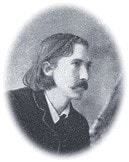 R.L. Stevenson left his donkey Modestine at St-Jean-du-Gard. And he went to Alès by stagecoach. So I extend his journey. Forward to this final stage! But it will not just be a quiet stroll in the plain. Through Mialet, I return to the hills on the markers of GR67. And beyond Aigladines, past the col d'Uglas, the GR44D begins a true roller coaster ride along a long, bumpy ridge. Nearly 700 to 800 m of elevation to scramble through the garrigue; the path, rocky and winding as I have rarely encountered since Brioude, weaves its way along the crest of the Malabouisse wood, in a tunnel of green oaks, boxwoods, and laurels; it climbs and descends in a chaos of limestone blocks. Immense solitude; throughout the day, not a single presence in the mountain. At most, one or two tile roofs down there, far in the valley of Galeizon, blurred in the mist of a humid and stormy day. A somewhat anxious solitude... I approach the goal, with mixed feelings. With a hint of apprehension. An accident, a stupid incident is always possible in this rocky terrain, on this chaotic path. And at the same time, do I really want to end this long hike? Not sure... I have just finished my last snack at the summit of Montcalm. And down there in the plain, the agglomeration of Alès appears to me, misty but very real; still a good hour to descend from these dear mountains. It is an unfortunate idea to end a hike in a big city. First sound: a police siren; first image: a huge housing block. Brutal contact with the human ant hill. Stage of 25 km.
R.L. Stevenson left his donkey Modestine at St-Jean-du-Gard. And he went to Alès by stagecoach. So I extend his journey. Forward to this final stage! But it will not just be a quiet stroll in the plain. Through Mialet, I return to the hills on the markers of GR67. And beyond Aigladines, past the col d'Uglas, the GR44D begins a true roller coaster ride along a long, bumpy ridge. Nearly 700 to 800 m of elevation to scramble through the garrigue; the path, rocky and winding as I have rarely encountered since Brioude, weaves its way along the crest of the Malabouisse wood, in a tunnel of green oaks, boxwoods, and laurels; it climbs and descends in a chaos of limestone blocks. Immense solitude; throughout the day, not a single presence in the mountain. At most, one or two tile roofs down there, far in the valley of Galeizon, blurred in the mist of a humid and stormy day. A somewhat anxious solitude... I approach the goal, with mixed feelings. With a hint of apprehension. An accident, a stupid incident is always possible in this rocky terrain, on this chaotic path. And at the same time, do I really want to end this long hike? Not sure... I have just finished my last snack at the summit of Montcalm. And down there in the plain, the agglomeration of Alès appears to me, misty but very real; still a good hour to descend from these dear mountains. It is an unfortunate idea to end a hike in a big city. First sound: a police siren; first image: a huge housing block. Brutal contact with the human ant hill. Stage of 25 km.
I enjoy a beer on the terrace of "Mal Assis" in the pedestrian area of Alès. And nostalgia already takes hold of me. This feeling is not new at the end of a long hike. But I feel it today with a particular sharpness; the beautiful adventure is truly over. I will reunite with my loved ones,... but also all the daily constraints. I must not lose the memory of the images, sensations, memories of emotions, the excitement of thought too quickly. "Resist" the wear of everyday life; is freedom not more in the head and heart than in the air of the mountains? by Jean Marie Maquet
Former holiday hotel with a garden along the Allier, L'Etoile Guest House is located in La Bastide-Puylaurent between Lozere, Ardeche, and the Cevennes in the mountains of Southern France. At the crossroads of GR®7, GR®70 Stevenson Path, GR®72, GR®700 Regordane Way, GR®470 Allier River springs and gorges, GRP® Cevenol, Ardechoise Mountains, Margeride. Numerous loop trails for hiking and one-day biking excursions. Ideal for a relaxing and hiking getaway.
Copyright©etoile.fr